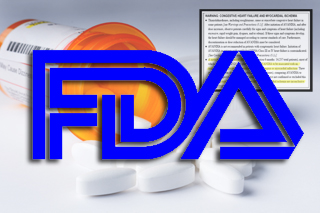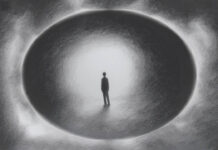In 2004 the FDA added a “black box” warning label to antidepressant prescriptions due to increased risk of suicide in children and adolescents taking the drugs. This came after evidence of higher suicide rates surfaced in placebo-controlled trials of the drugs.
However, since then, the warning label has been controversial. Critics have suggested that it may have resulted in decreasing antidepressant prescriptions and increased suicide rates.
A new study investigated these claims. Did the black box warning label cause harm by preventing antidepressant prescriptions to children?
Not according to the researchers, who write:
“The Black Box warning is rooted in solid data, whereas attempts to claim the warning has caused harm are based on quite weak evidence.”
 The researchers, led by Glen Spielmans at Metropolitan State University in Minnesota, published their findings in the journal Frontiers in Psychiatry. According to Spielmans and his co-authors, antidepressant prescriptions have continued to increase, along with the rise in suicide attempts in young people.
The researchers, led by Glen Spielmans at Metropolitan State University in Minnesota, published their findings in the journal Frontiers in Psychiatry. According to Spielmans and his co-authors, antidepressant prescriptions have continued to increase, along with the rise in suicide attempts in young people.
“Recent data suggests that increasing antidepressant prescriptions are related to more youth suicide attempts and more completed suicides among American children and adolescents,” the researchers write.
The researchers also critique articles that have suggested the opposite. Studies that found suicide attempts increasing along with decreased antidepressant prescriptions suffered from many methodological problems. For instance, some of these studies don’t do a statistical analysis; others don’t control for other variables that might impact the results; some use “questionable” end-points that “distort” the data or use “questionable measures of suicide attempts”—such as depression rating scales that do a poor job of identifying suicidality.
All of this adds up to a bevy of misleading studies purporting to demonstrate harm from the FDA’s warning—and ignoring the actual data, according to Spielmans and his co-authors.
Other studies have looked more closely at the data. After the black box warning was instituted, suicide rates decreased along with antidepressant prescriptions for three years. However, after about 2007, antidepressant prescriptions began climbing again, and suicide rates followed suit.
Spielmans and his co-authors make a point to remind the reader that the best evidence available demonstrates increased suicide risk for youth taking antidepressants:
“Case-control studies show increased risk of suicide attempts and suicide among youth taking antidepressants, even after controlling for some relevant confounds,” they write.
Clinical trials are among the best at controlling for confounding factors, according to the researchers, and “such trials demonstrated an increased risk of suicidality adverse events among youth taking antidepressants.”
Before instituting the black box warning, the FDA convened a panel of suicide experts at Columbia University to assess suicide risk in youth taking antidepressants. The panel was appropriately blinded (they didn’t know whether they were looking at antidepressant or placebo data) until after they reviewed the data from the clinical trials.
According to Spielmans and his co-authors, the panel’s finding was that youth taking antidepressants experienced a 71% increase in suicidality and a 79% increase in agitation/hostility when compared with youth taking placebo.
Published articles are known for hiding adverse events, including suicidality. According to the researchers, “Across 142 trials of six psychiatric medications, 62.3% of deaths, 53.3% of suicides, and 46% of suicidal ideation/attempts/injury events that appeared in the online registries did not appear in the published journal articles. […] Adverse events were sometimes labeled as ‘worsening depression’ or ‘emotional lability’ when, in fact, the relevant descriptive narratives in the clinical study reports clearly describe suicide attempts.”
Most importantly, the researchers suggest that keeping doctors, youth, and their parents informed about potentially deadly risks—as the black box warning is designed to do—is in keeping with the best principles of the medical field.
****
Spielmans, G.I., Spence-Sing, T., & Parry, P. (2020). Duty to warn: Antidepressant black box suicidality warning is empirically justified. Frontiers in Psychiatry, 11, 18. DOI: 10.3389/fpsyt.2020.00018 (Link)














…71% increase in suicidality……
And these are not pulled from the market for what reason?????
Oh yeah, $$$$$.
Profits over people.
Disgraceful!
Report comment
That’s why you don’t pay attention to company-funded studies that will always puff the effectiveness of the drugs they’re manufacturing, while hiding the disabling side effects to puff future sales. Think of the companies’ “studies” as advertising instead of science, as advertising doesn’t have to be truthful about anything unless governments force this undesirable practice on companies.
Report comment
Those warnings should be on buses, in schools.
“drugs can kill, including psychiatric or other chemicals”.
It is time to educate kids and parents about the dangers of all drugs, all chemicals including “gabapentin”.
Of course hopelessness and despair causes deaths. Drugging will absolutely not solve that.
The answer is not to do nothing in the absence of drugs.
The answer remains one of true support, ongoing which psychiatry seems incapable of.
If psychiatry cannot be a support, if they have nothing to offer but labels and chemicals, then perhaps it is time for them to be ousted.
Report comment
Suicides from antidepressants, inborn schizophrenia from head injury, smells like it is marijuana plants.
Report comment
The mere fact that a “bevy of misleading studies purporting to demonstrate harm from the FDA’s warning—and ignoring the actual data” exists, is proof of extreme pro-psychiatry bias, in research and research funding.
That black box warning should also include warnings that the antidepressants can create “manic” like symptoms, which will result in “bipolar” misdiagnoses.
https://www.alternet.org/2010/04/are_prozac_and_other_psychiatric_drugs_causing_the_astonishing_rise_of_mental_illness_in_america/
Especially since this slice of wisdom was taken out of the DSM5:
“Note: Manic-like episodes that are clearly caused by somatic antidepressant treatment (e.g., medication, electroconvulsive therapy, light therapy) should not count toward a diagnosis of Bipolar I Disorder.”
The black box warning should also warn that the antidepressants can make a person “psychotic,” via anticholinergic toxidrome poisoning. But this, too, will result in “bipolar” or “schizophrenia” misdiagnoses, since anticholinergic toxidrome is not listed in the DSM billing code “bible.”
https://en.wikipedia.org/wiki/Toxidrome
I agree the black box warning on antidepressants is justified, but it is not sufficient.
Report comment
How much harm was done by SSRIs during the first 10+ years after they came on the market with no warnings attached? I wonder what list of side effects came with a Prozac prescription in 1998. Probably nothing about worsening depression and anxiety, akathisia, homicidal and suicidal thoughts.
How many tragedies happened in those first 10+ years that were never traced back to Prozac (or paxil or zoloft etc)?
Report comment
Prozac was actually NOT approved in Germany, and I believe Italy as well, due to suicidal and aggressive impulses being aggravated or induced by the drug. This was known information from day one.
Report comment
Steve, I didn’t realize this. Was this information that came up in the initial studies of Prozac?
Report comment
Yes. It was a known concern before it was approved.
“Those who developed akathisia or who had any suicidal tendencies were excluded from the trial data on the basis that they would otherwise obscure the results of the drug’s success in treating depression. Yet the German licensing authority, the Bundes Gesundheit Amt (BGA), on scrutinising the results, expressed concerns about the drug’s safety. On May 25, 1984, according to Lilly’s internal documents, a letter from the BGA stated: “During the treatment with the preparation [Prozac], 16 suicide attempts were made, two of these with success. As patients with a risk of suicide were excluded from the studies, it is probable that this high proportion can be attributed to an action of the preparation [Prozac].”
https://www.theguardian.com/theguardian/1999/oct/30/weekend7.weekend1
Report comment
This helps me see what happened to me, with better insight.
It is amazing that psychiatry talks about “insight”, and really it is something we finally slowly come to after many years.
And one of the insights is how psychiatry is the most damaging system, and I include my kind GP in this, who I had for 26 years, who was anti-psychiatry yet prescribed Prozac.
It is difficult to assess “kindness”, and I am only realizing that now.
And guess what, I have always had insight, but I did not know how to act on it.
Report comment
I think it is scientifically accepted that ‘Antidepressants’ cause suicide and homicide in a (so called) small percentage of people that consume them.
Report comment
You wont find David Healy being allowed on the Guardian now – it’s become a sock puppet of UK psych/pharma.
Report comment
I have only been practicing four and a half years, but my case load is very high, and my anecdotal observations completely support the conclusions of this article.
When young people, in particular, are prescribed SSRIs, only an idiot could ignore the risks– fortunately, about half the kids (in the population I serve) recognize the side effects within DAYS, report them, and go to their psychiatrist to demand that they be taken off the drugs.
But it seems like there are at least 30% of the cases that just spiral into semi-suicidal hell. Treating a non-medicated suicidal young adult isn’t easy, either, but they usually don’t spiral into this completely unnatural state of consciousness where they can be climbing out of depression and then impulsively experimenting with methods either at the same time, or alternating rapidly between one state of mind and the other. With an unmedicated patient, you at least have a sense of which way things are going– if they’re seeing their friends and making plans for the future, that’s usually a positive sign. With patients taking SSRIs, you just can’t be as sure of that, you have to monitor much more closely. The kid is more likely to have a run of a few good days, and then just start spiraling again very, very rapidly. If alcohol, recreational cannabis, or other drugs are part of the picture as well, often you get into this spiral of constant check-in calls without knowing whether or not you’re making progress. The suicidal thoughts don’t go away, they morph into something else where they kind of lurk for a few weeks, only to come roaring back later.
Report comment